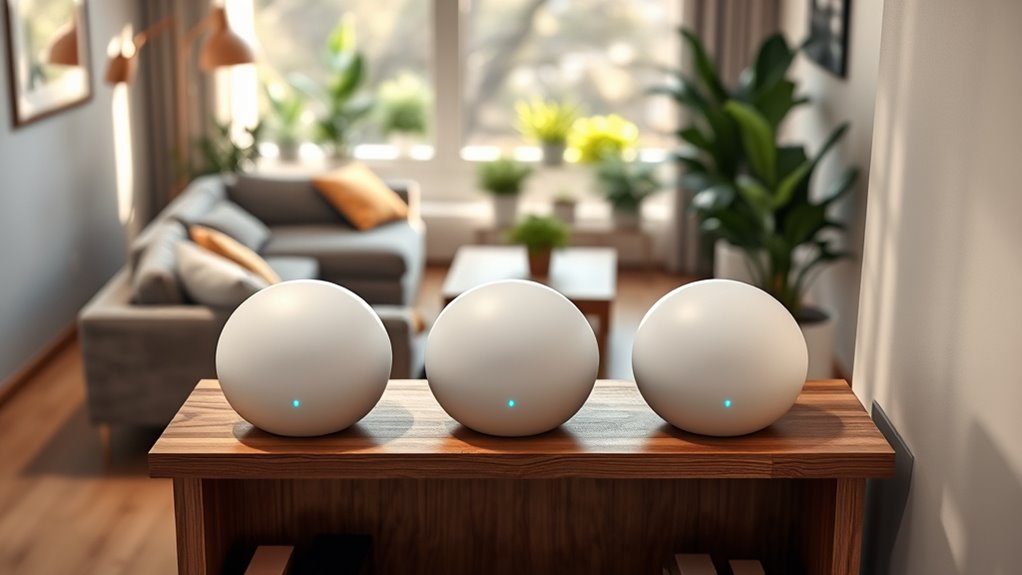To improve Wi-Fi coverage in your apartment, a mesh Wi-Fi system is your best option. It creates seamless network connections, eliminating dead zones and supporting multiple devices. Prioritize systems with Wi-Fi 6 or Wi-Fi 6E, easy setup, and Ethernet backhaul for stability. Proper node placement—high and spaced apart—also boosts performance. Keep interference low by positioning devices away from electronics. Want tips on choosing the right system and placement strategies? Keep going to learn more.
Key Takeaways
- Use mesh Wi-Fi systems supporting Wi-Fi 6 or Wi-Fi 6E for faster, more reliable coverage across your apartment.
- Position nodes high and spaced 10-15 feet apart to maximize coverage and reduce dead zones.
- Enable Ethernet backhaul for stable, wired connections that enhance overall network performance.
- Choose compact, easy-to-install nodes that blend with decor and cover over 1,000 sq ft effectively.
- Manage interference by keeping electronic devices away from nodes and optimizing placement for seamless connectivity.
Understanding the Benefits of Mesh Wi-Fi for Apartments
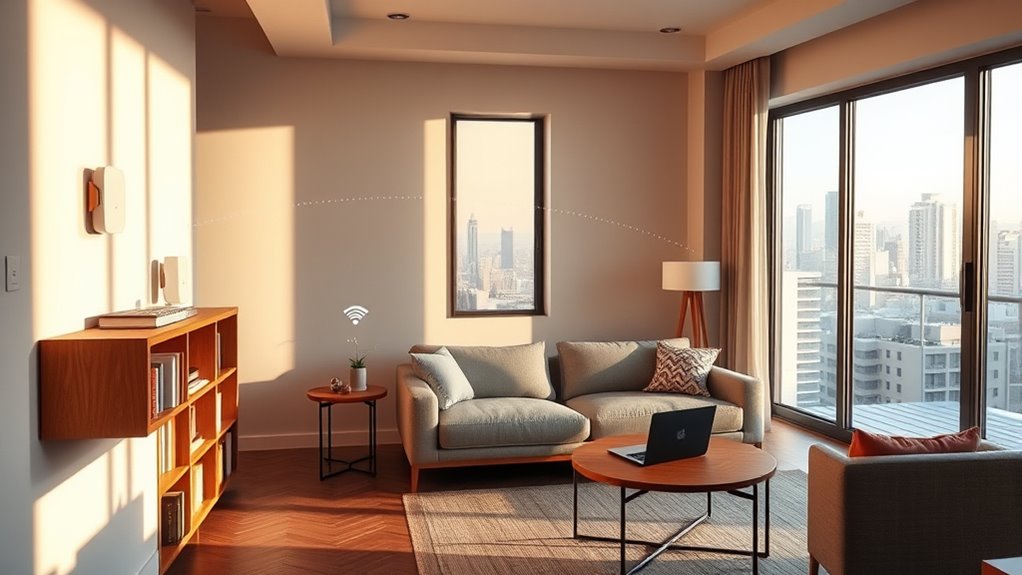
If you live in an apartment, a mesh Wi-Fi system can considerably improve your internet experience. Unlike traditional routers, mesh systems use multiple nodes to create a seamless wireless network, eliminating dead zones and ensuring consistent coverage throughout your space.
They automatically select the strongest signal, maintaining peak signal strength across rooms and floors. Mesh networks support advanced features like Ethernet backhaul, which boosts performance and stability, especially in dense apartment buildings with interference from neighboring networks.
Proper placement and wired backhaul options help maximize coverage and reduce channel interference, leading to better coverage optimization. With mesh Wi-Fi, you’ll enjoy a reliable, fast connection everywhere in your apartment, making buffering and slow downloads a thing of the past.
Key Features to Consider When Choosing a Mesh System
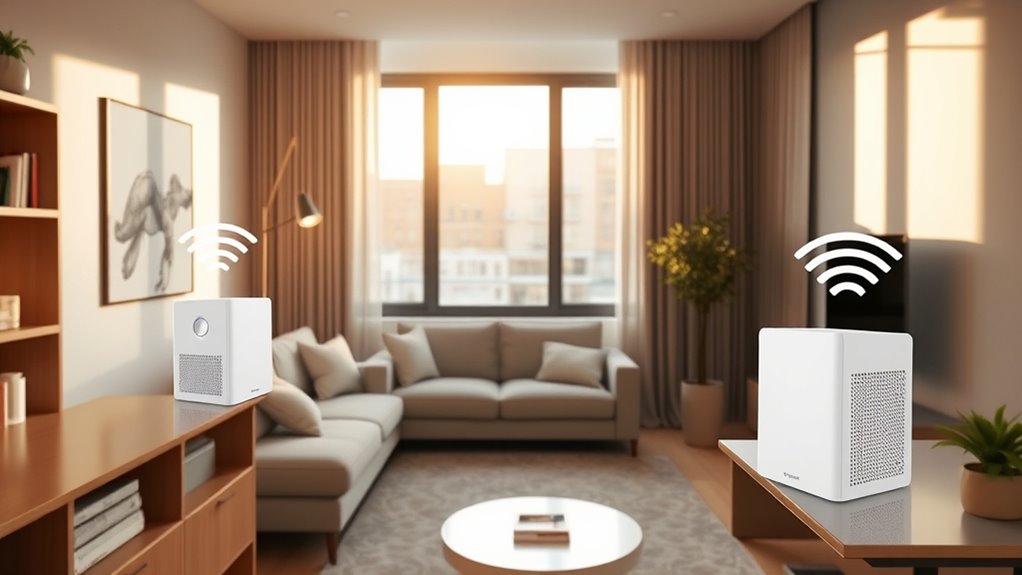
When selecting a mesh Wi-Fi system, focusing on key features can guarantee you get reliable, high-performance coverage tailored to your needs. Consider these vital factors:
- Support for Wi-Fi 6 or Wi-Fi 6E to boost wireless connectivity and device capacity.
- Multiple Ethernet ports per node for wired backhaul, enhancing stability and performance.
- Easy setup and remote management through an app, simplifying installation and control. Additionally, look for systems that support mesh networking protocols to ensure seamless communication between nodes and optimal coverage.
- Coverage area based on the number of nodes, ensuring ample coverage for your apartment size, along with robust security protocols like WPA3 to safeguard your network. Incorporating data-driven strategies can help you select the most suitable system based on your specific environment.
Furthermore, considering interference management features can improve overall network reliability, especially in densely populated apartment complexes. Verify the system’s ability to handle high device counts, essential for smart devices, streaming, and work-from-home setups. Implementing performance optimization techniques can further enhance network stability and speed. Lifestyle considerations such as creating a comfortable and organized environment can further enhance your overall remote work experience.
These features help you pick a mesh system that’s reliable and future-proof.
Top Mesh Wi-Fi Systems Suitable for Apartment Living

When choosing a mesh Wi-Fi system for your apartment, compact design options help you keep your space clutter-free.
Easy setup features make getting your network running quick and hassle-free.
Reliable signal coverage guarantees every corner of your apartment stays connected without dead zones.
Compact Design Options
Compact mesh Wi-Fi systems are an excellent choice for apartment living because they combine powerful coverage with sleek, unobtrusive designs. These systems feature small, lightweight nodes that easily fit on shelves or desks, helping you avoid clutter. Many models, like the Asus ZenWiFi BQ16 Pro, showcase minimalist aesthetics with low-profile routers that blend into your decor seamlessly. Furthermore, their compact design often incorporates space-saving features, making them ideal for limited spaces. Additionally, their rustic-inspired designs often incorporate natural materials and warm tones, making them visually appealing in a variety of interior styles. These systems also utilize mesh networking technology, which ensures seamless connectivity across your entire living space. The durability of these materials and the aesthetic versatility of compact models help maintain a stylish, functional environment. Here are some key features:
- Small form-factor nodes that don’t take up much space.
- Unobtrusive design that complements modern apartment styles.
- Mesh systems capable of supporting multiple devices simultaneously.
- Robust coverage over 1,000 sq ft, ideal for most apartments.
These compact systems deliver strong Wi-Fi signals without sacrificing style or space.
Easy Setup Features
Looking for a mesh Wi-Fi system that’s easy to set up in your apartment? Many top systems, like the Eero 6 Plus and TP-Link Deco X90, feature user-friendly mobile apps that guide you through setup in minutes. These systems often include quick-start guides and intuitive interfaces, making network setup straightforward even if you’re not tech-savvy.
Automatic device detection and optimized placement suggestions help guarantee strong coverage. Some models support one-touch setup with QR codes or NFC pairing, reducing setup time and simplifying connections.
Additionally, firmware updates are managed seamlessly via the app, keeping your network secure and efficient. Remote management allows you to add or reposition nodes, monitor network status, and perform updates from your smartphone, making ongoing maintenance effortless.
Reliable Signal Coverage
To guarantee dependable Wi-Fi coverage throughout your apartment, you need a mesh system that fits your space and minimizes dead zones. Top mesh systems like the Eero 6 Plus and TP-Link Deco S4 reliably cover up to 2,500 sq ft, reducing interference and ensuring smooth Wi-Fi coverage. Incorporating the latest wireless standards ensures compatibility with evolving devices and enhances overall performance.
Consider these factors:
- Mesh routers with Wi-Fi 6E, like the eero Pro 6E, provide more consistent signals across multiple devices.
- Mesh systems supporting Ethernet backhaul, such as the Asus ZenWiFi AX, improve signal stability in multi-room layouts, especially when optimizing space and organization in your apartment.
- Proper mesh node placement—high and unobstructed—enhances apartment coverage and reduces dead spots, which is crucial for maintaining reliable connectivity.
- Mesh systems with interference reduction features help maintain reliable Wi-Fi even in crowded apartment complexes.
- Understanding the latest industry trends can help you select a system that stays current with evolving wireless technologies, including advancements in security and performance. Additionally, selecting a system with security features can safeguard your network from potential threats.
Choosing the right system ensures strong, stable signal coverage throughout your apartment.
Optimal Placement Strategies for Mesh Nodes in Small Spaces

Proper placement of mesh nodes is essential for achieving strong, reliable Wi-Fi coverage in small spaces. Focus on ideal mesh node placement by positioning nodes high on shelves or wall mounts to maximize signal dispersion and reduce obstructions.
Position mesh nodes high on shelves or walls to boost Wi-Fi signal strength and reduce obstructions.
Keep nodes at least 10-15 feet apart, avoiding walls, metal objects, or large appliances that hinder signal propagation. The central router placement should be near the apartment’s core to ensure balanced apartment Wi-Fi coverage.
Use Ethernet backhaul when possible for interference reduction and network stability. Wall mounts help elevate nodes above furniture and obstacles, improving coverage. Additionally, staying aware of potential sources of interference, such as electronic devices, can help maintain optimal signal strength. Also, stay clear of electronic devices like microwaves or cordless phones that emit interference on the 2.4 GHz and 5 GHz bands. Proper node positioning enhances performance and reliability. Additionally, understanding Louisiana Alimony Laws can be important for residents navigating post-divorce housing and financial arrangements, ensuring stability in your living situation. Implementing mesh network best practices can further optimize coverage and connection quality throughout your apartment.
Comparing Wi-Fi 6, 6E, and 7 Mesh Options for Apartments
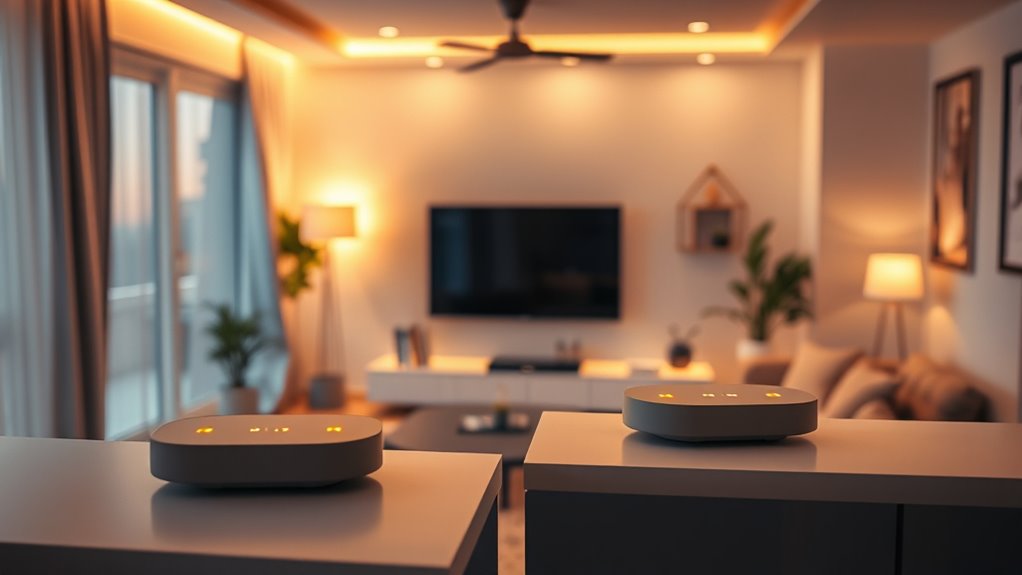
When choosing a Wi-Fi mesh system for your apartment, speed and connectivity are key factors to contemplate. To ensure seamless communication between devices, selecting a system that fosters active listening and empathy can enhance your overall network experience. Future-proofing and compatibility with your devices can also influence your decision, especially as technology advances. Understanding the differences between Wi-Fi 6, 6E, and 7 helps you pick the right system for your needs. Additionally, considering the wireless standards can help you determine which system will offer the best performance for your specific environment. Moreover, staying informed about tuning options and updates can optimize your network’s stability and security over time. Being aware of potential degradation factors like interference or physical obstructions can also help you maintain a strong connection. Recognizing the importance of compatibility with existing devices can further ensure your network remains reliable and efficient.
Speed and Connectivity
Choosing the right Wi-Fi mesh system for your apartment hinges on understanding their speed and connectivity capabilities. Wi-Fi 6, 6E, and 7 each offer distinct advantages:
- Wi-Fi 6 delivers speeds up to 9.6 Gbps, supporting multiple devices with improved efficiency.
- Wi-Fi 6E operates on the 6GHz band, reducing interference and providing faster, more stable connections often exceeding 1 Gbps.
- Wi-Fi 7 supports multi-gigabit speeds up to 30 Gbps, with advanced features like 4096-QAM for high-bandwidth connectivity.
- Upgrading enhances mesh network performance, latency, and signal stability, especially when using wired backhaul for better apartment coverage.
Future-Proofing and Compatibility
Advancements in Wi-Fi technology are making it easier for apartment residents to future-proof their networks. Wi-Fi 6, 6E, and 7 mesh systems offer compatibility across multiple standards, allowing you to upgrade gradually without replacing existing hardware.
Wi-Fi 6 mesh systems, like Asus ZenWiFi AX, support multi-gigabit speeds and improved efficiency, guaranteeing your network can handle growing demand.
Wi-Fi 6E, such as eero Pro 6E, operates on the 6GHz band, providing less interference and higher speeds suited for dense apartment environments.
Wi-Fi 7, like Netgear Orbi 970, promises even higher throughput with multi-gig ports and 16 streams, perfect for advanced smart homes and device density.
These multi-band systems ensure seamless integration, future-proofing your network for years to come. Ethical Hacking principles can also be applied to identify potential vulnerabilities in your network setup, ensuring your smart home remains secure as you upgrade.
Tips for Maximizing Speed and Coverage in Compact Homes
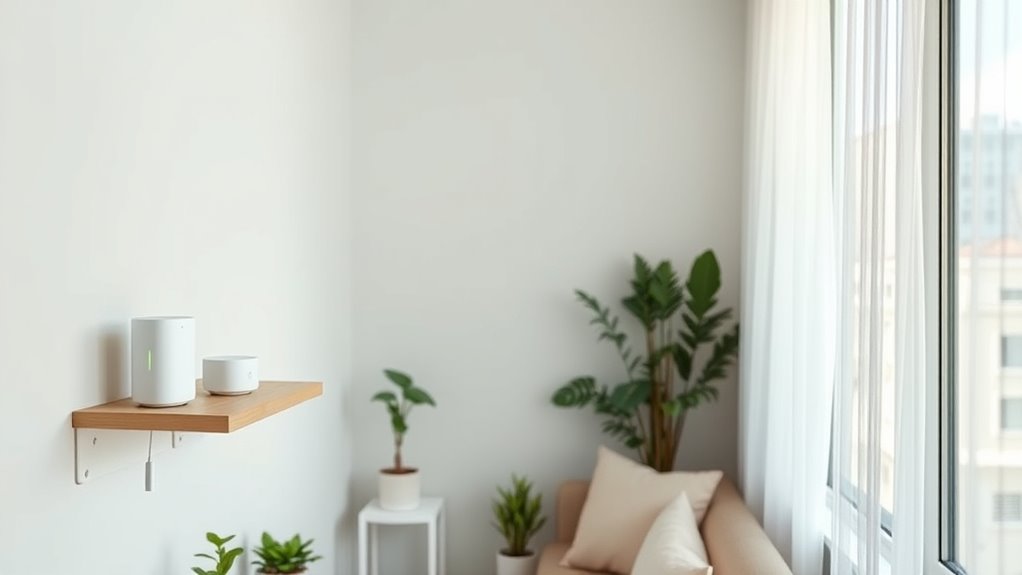
Maximizing Wi-Fi speed and coverage in compact homes requires strategic placement and configuration of your mesh system. Here are some tips:
- Place mesh nodes high on shelves or wall mounts to minimize obstructions and enhance signal overlap.
- Use Ethernet backhaul cables between mesh units when possible, boosting stability and reducing wireless interference.
- Choose dual-band or tri-band systems that can automatically switch channels to avoid congestion.
- Position the main router near the apartment’s center and keep it clear of thick walls or metal objects to improve coverage.
Limiting connected devices during high-demand activities also prevents bandwidth bottlenecks.
Proper placement and smart choices in your mesh system’s setup make all the difference in getting the best speed and coverage in your small space.
Making the Switch: Transitioning From Traditional Routers to Mesh Networks
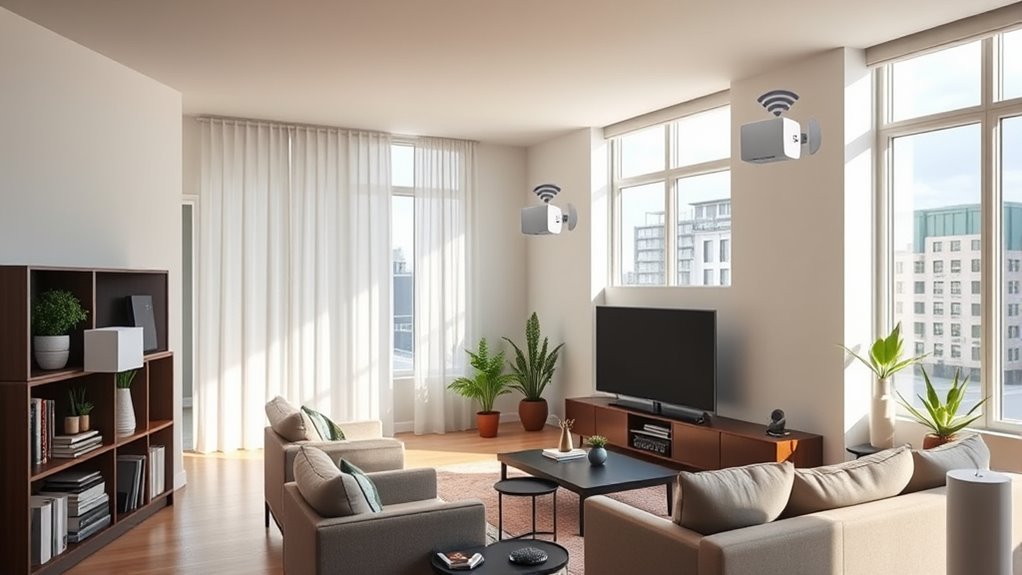
Thinking about upgrading your Wi-Fi setup? Moving from traditional routers to mesh networks is straightforward and offers seamless coverage for your apartment Wi-Fi. Instead of relying on a single router, you add multiple mesh nodes that work together for reliable signal reliability and fewer dead zones. With automatic network switching, you won’t need to manually reconnect devices as you move around. Many mesh systems support wired Ethernet backhaul, boosting performance and stability. Setting up your mesh system is simple with user-friendly apps, making the process quick and hassle-free. Here’s a quick comparison:
| Traditional Router | Mesh Network Setup |
|---|---|
| Single point of failure | Multiple mesh nodes for coverage |
| Manual network switching | Automatic device connection |
| Wireless-only | Wired Ethernet backhaul options |
Frequently Asked Questions
Is Mesh Wifi Good for an Apartment?
You’re wondering if mesh Wi-Fi is a good choice for your apartment. It can be, especially if you have a larger space or dead zones that a single router can’t cover well.
Mesh systems with multiple nodes, particularly with Ethernet backhaul, give you faster, more stable connections.
Just make sure to place the units strategically, high up and away from obstructions, for the best coverage and performance.
What Is the Best Mesh Router for Apartment?
You’re asking about the best mesh router for an apartment. For ideal coverage, consider the Asus ZenWiFi AX (XT8), which offers strong tri-band Wi-Fi 6 support and easy setup, reducing interference in complex buildings.
If wiring is available, the TP-Link Deco XE75 with Ethernet backhaul provides faster, more reliable connections. Both options help guarantee seamless Wi-Fi across your space, minimizing dead zones and handling multiple devices effortlessly.
Will a Mesh Network Improve Coverage?
Imagine your Wi-Fi as a team of explorers maneuvering your apartment’s terrain. A mesh network acts like a master map, guiding signals smoothly through every room.
It dynamically routes data around obstacles, reducing dead zones and congestion. You’ll notice faster streaming, seamless device connections, and fewer drops.
What Is a Major Disadvantage of a Mesh Network?
A major disadvantage of a mesh network is that your performance can suffer if the nodes aren’t placed correctly or if they connect wirelessly instead of wired. This can cause slower speeds, higher latency, and reduced reliability.
Additionally, mesh systems tend to be more expensive than traditional routers, which mightn’t fit your budget.
Interference and limited Ethernet ports can also further impact your network’s overall performance.
Conclusion
Think of your apartment’s Wi-Fi as a web of connectons—strong, seamless, and everywhere you need it. By choosing the right mesh system and placing your nodes wisely, you’ll transform your space into a well-orchestrated network symphony. Say goodbye to dead zones and slow spots; instead, enjoy smooth streaming and fast downloads across every corner. With a little setup, your Wi-Fi will be as reliable as the air you breathe—essential and effortless.
